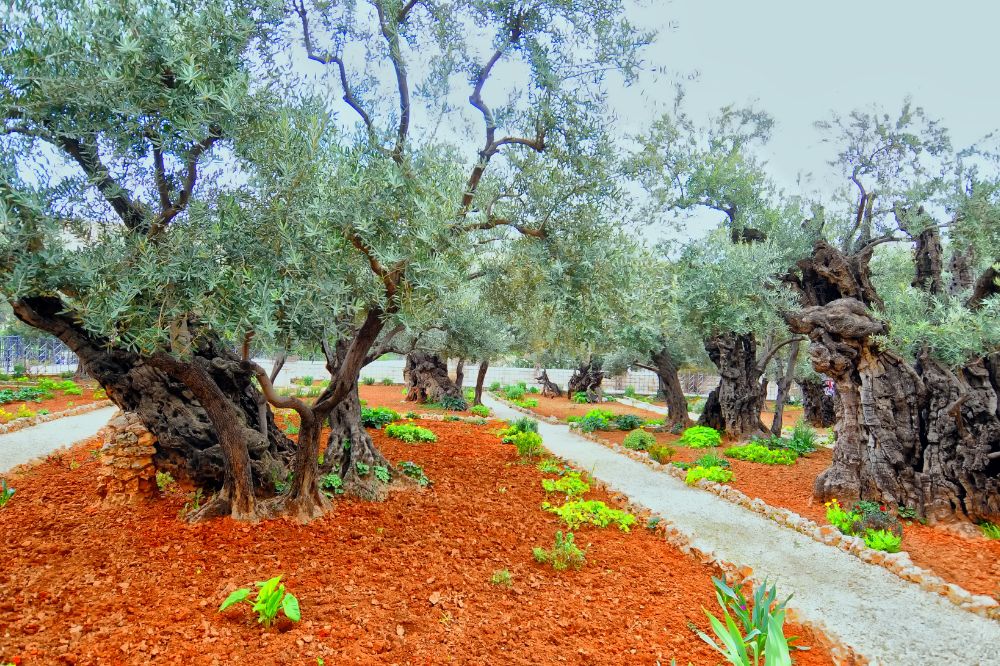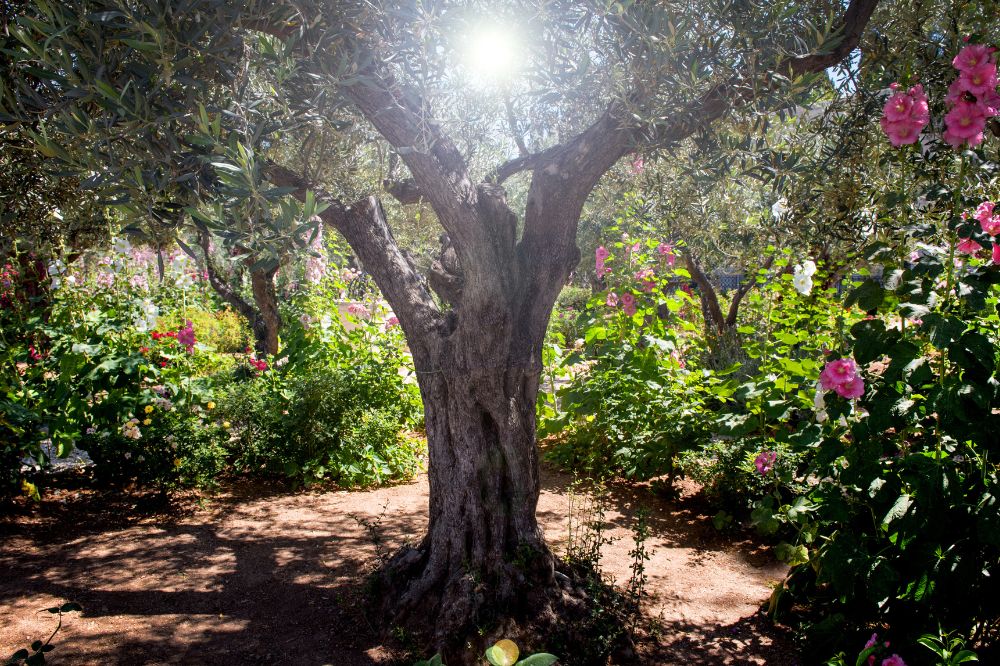
The Garden of Gethsemane is an emblematic place for the Christian faith, laden with profound spirituality and historical significance. This sacred place is known as the setting where Jesus spent his last hours before being arrested, experiencing moments of intense prayer and emotional anguish.
Gethsemane, which in Aramaic means oil press, symbolizes not only the physical and spiritual pressure that Jesus faced but also the act of submission and sacrifice that defined that critical moment.
This guide seeks to explore the rich history of Gethsemane, unraveling the layers of devotion and reverence that have surrounded this garden over the centuries. Additionally, we will delve into the spirituality that emanates from this place, reflecting on how Jesus’s experience here continues to resonate in the hearts of believers today.

This place is one of the most revered in Christian pilgrimages , located in a geographically and spiritually significant position: ** at the foot of the Mount of Olives.
This place offers an exceptional panoramic view of Jerusalem. But more than that, it is imbued with a deep history intertwined with the events narrated in the Bible. The importance of Gethsemane and its connection with the Mount of Olives is key to understanding both the physical and spiritual context in which Jesus spent his last hours before his arrest.
Gethsemane is situated on the western slope of the Mount of Olives, very close to the walls of the ancient city of Jerusalem. This garden, traditionally known for its ancient olive trees, offers a setting that has remained relatively untouched over the centuries, maintaining the solemnity that characterizes it.
In Jesus’s time, it was not only significant for its proximity to the holy city of Jerusalem. It was also a meeting point for those seeking a moment of retreat and reflection away from the city’s bustle.
This sacred place represented a space of tranquility where Jesus Christ and his disciples frequently gathered, highlighting its importance as a site of contemplation and prayer.
The Gospels of Matthew, Mark, and Luke describe in detail the night Jesus spent in Gethsemane before being handed over to the authorities.
This place is specifically cited as the setting where the Son of God experienced one of his deepest anguishes. He prayed fervently and sought comfort in the presence of his Father while his disciples struggled against sleep.
The Gospel accounts emphasize Jesus’s emotional intensity during those critical hours. They also illustrate how this place becomes the axis around which transcendental events revolve, culminating in the crucifixion and subsequent resurrection.
These texts offer multiple layers of interpretation about sacrifice and surrender. They highlight the importance of this garden as a physical place and a symbolic threshold in the narrative of Christ’s Passion.

This garden, located near the Holy Land, near the emblematic Western Wall, is much more than a simple geographical point. It is a place of immense spiritual and emotional weight in the Christian tradition.
This sacred site symbolizes moments of profound introspection and spiritual connection, marked by prayer and Jesus’s acceptance of divine destiny. Through the events that took place here, it reveals itself as a fundamental setting for understanding the humanity and divinity of Jesus.
The night before his crucifixion, Jesus withdrew to Gethsemane with his disciples. This moment is one of the most intense and personal in the New Testament. According to biblical accounts, Jesus distanced himself from his followers and prayed fervently, facing a state of anguish at the suffering he knew awaited him.
“Father, if you are willing, take this cup from me; yet not my will, but yours be done,” he expressed in his prayer, demonstrating his internal struggle and deep faith. This prayer not only reflects his vulnerability but also his unwavering obedience and trust in the path that God had set for him.
The act of praying is also a profound act of sacrifice and submission to divine destiny. In this place, Jesus fully accepts his role in the salvation of humanity, symbolizing this act as an unconditional commitment to his salvific mission.
This event is fundamental to understanding the concept of voluntary sacrifice and Jesus’s acceptance of his destiny. Both are central aspects of the Christian faith that resonate in the hearts of the faithful and pilgrims who visit this holy place.
This garden not only witnesses Jesus’s agony but also his unwavering faith and acceptance of the divine plan, elements that continue to inspire pilgrims on their spiritual journey.
This is a key setting in the narrative of Christ’s Passion, located near the tomb of Jesus and deeply rooted in the events that define Holy Week.
This place encapsulates Jesus’s pain and marks the beginning of the path to his arrest and crucifixion. Both are central events in the Christian faith and have made Gethsemane a place of reflection and pilgrimage. Here, Jesus confronts the reality of his destiny, offering an example of obedience and faith that would resonate throughout the generations.
This moment is crucial because it marks Jesus’s transition to his final surrender. It symbolizes the struggle between the human desire to avoid suffering and the divine acceptance of the sacrifice necessary for the redemption of humanity.

The arrest of Jesus Christ is one of the most dramatic and significant moments that occur in this sacred site. After his intense prayer, he is confronted by Judas Iscariot, one of his own disciples, who betrays him with a kiss, indicating to the Roman and religious authorities that they should arrest him.
This act not only marks the beginning of his suffering and Passion, it also underscores human betrayal and the fulfillment of biblical prophecies. The arrest triggers a series of events that culminate in the crucifixion, making this garden a place of prayer and a silent witness to the transition to the supreme sacrifice.
This place continues to be an important destination for pilgrims from around the world. This sacred garden offers a window into the biblical past and a space for personal reflection and spiritual encounter.
Pilgrimages are a tradition that has evolved over the centuries, reflecting the unwavering devotion and desire of the faithful to literally walk in Jesus’s footsteps.
Since the early centuries of Christianity, this has been a place of pilgrimage. Initially visited by local faithful, its fame grew as news of its significance spread through pilgrim accounts and the writings of the church fathers.
Throughout the Middle Ages, it became established as a pilgrimage destination. It attracted believers from all over the Christian world, eager to pray where Jesus had his most human and divine moments. In the current context, it attracts not only those seeking to deepen their faith but also those interested in the history and culture of the region.
The continuity of these pilgrimages demonstrates the eternal relevance of Gethsemane as a site of meditation and prayer. It highlights its role in the history of Christianity and serves as a bridge between traditions and cultures.
Visiting Gethsemane, pilgrims encounter a place that has been carefully preserved to reflect its historical state as much as possible.
The olive garden, some of which are millennia old, offers an atmosphere of tranquility and awe. It is a place that invites introspection and reverence, allowing visitors to feel a direct connection with the events of the past.
For those who pilgrimage to this place, it is recommended to dedicate time to personal prayer, participate in the liturgies regularly offered, and silently contemplate the mysteries of the Passion. Many visitors find comfort and strength in following in Jesus’s footsteps, reflecting on his sacrifice and surrender.

The Mount of Olives is traditionally recognized as the place of Jesus’s Ascension to heaven, an event described in the book of Acts.
According to the biblical account, Jesus, after resurrecting and appearing to his disciples for forty days, was taken up to heaven before their eyes. This event is crucial not only for its miraculous nature but also for its theological significance, marking the end of Jesus’s earthly mission and the beginning of his heavenly ministry.
The specific site of the Ascension has been venerated since early Christianity. Today, a chapel known as the Chapel of the Ascension marks this historic place. Although it was originally a Christian church, it is now a sacred site for both Christians and Muslims.
Moreover, visiting this place offers pilgrims and visitors a panoramic view of the ancient city and its surroundings and is an opportunity to meditate on the meaning of the Ascension: Jesus’s promise to be with his followers “always, to the very end of the age,” and the hope of his return that sustains the Christian faith.
Additionally, the Mount of Olives offers other sites of interest such as the Church of All Nations, also known as the Basilica of the Agony. It is located very close to Gethsemane and is famous for its impressive architecture and mosaics that depict scenes from Jesus’s last days on Earth.
In Gethsemane, Jesus experiences one of the most intense trials of his life. His struggle and anguish in the garden illustrate Jesus’s
full humanity, who, despite his divinity, faced fears and sufferings that are profoundly human.
The most impactful spiritual lesson is that of submission to divine will. Jesus, in the midst of his agony, completely surrenders to God’s will, saying: “Not my will, but yours be done.” This act of submission is not one of passive resignation but of active acceptance of the divine plan, reflecting profound faith and trust in God.
Prayer in Gethsemane highlights its importance as a pillar of spiritual life. Jesus, in his darkest hour, resorts to prayer as an essential means of communication with the Father. This practice is a model to follow and an invitation to deepen our own spiritual life through prayer and meditation.
Prayer, as presented in Gethsemane, is a powerful tool to face challenges and tribulations. It provides strength, comfort, and clarity in times of uncertainty.
Meditating on the events of Gethsemane can inspire believers to adopt a similar stance of openness and acceptance towards divine will, especially in times of difficulty. Additionally, the practice of prayer and meditation fosters a deeper connection with God. It allows believers to seek guidance and support and cultivate a sense of peace and purpose in their lives.
Artistic representations of Gethsemane often focus on Jesus’s intense night of prayer before his arrest. Artists such as El Greco, Heinrich Hofmann, and Carl Bloch have interpreted this moment with a drama and intensity that reflect Jesus’s anguish and solemn resignation.
In these works, it is common to see Jesus in a pose of deep prayer or anguish. The disciples, often depicted in the background, sleep, underscoring the solitude and weight of the moment that Jesus faced alone.
These representations serve as visual devotionals and offer viewers a window into Christ’s humanity and his experience of suffering.
In music, it has been explored in genres ranging from classical music to modern rock.
Literature has also found a rich and profound theme. Writers like Nikos Kazantzakis in his novel “The Last Temptation of Christ” explore the psychological and spiritual complexities of Jesus in the garden. It offers perspectives that challenge and deepen the traditional understanding of these events.
These literary works allow readers to explore the deeper dimensions of faith and sacrifice, making this place a setting of spiritual conflict and personal and divine revelation.
Stay Connected with WayHoly
Discover your perfect pilgrimage and be the first to know about new journeys. By subscribing to our newsletter, you’ll receive the latest updates on pilgrimages, exclusive offers, and spiritual resources to enrich your faith journey.
Don’t miss the opportunity to deepen your connection with God and lead others on their path to spiritual renewal. Join us today and become an instrument of His Will through WayHoly!
“To upload your pilgrimage, please choose one of our plans and create an account, or log in if you’re already a member. Join us in guiding others on their spiritual journey.”